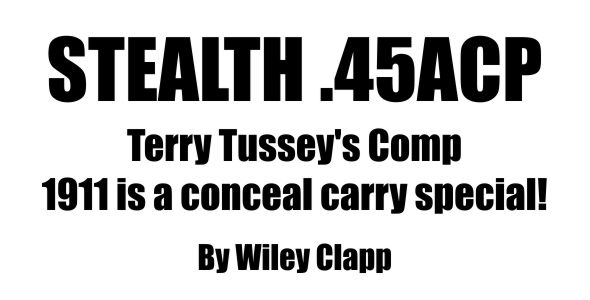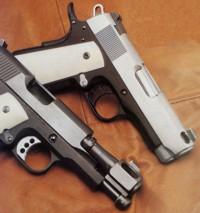 I don’t like compensators. To my traditionalist’s eye, they are funny-looking contraptions better suited to imaginary guns in Star Wars movies. Real men all enjoy a little recoil, so why why would you want to put some roonie-looking whatchamacallit on the end of your shooting iron to shield you from a little discomfort? Besides, these chunks of sewer pipe with holes in them are supposed to work on principles that border on the black arts, vectoring gas around corners and the like. It might as well be voodoo, for all I know. Sooo…I don’t like compensators.
I don’t like compensators. To my traditionalist’s eye, they are funny-looking contraptions better suited to imaginary guns in Star Wars movies. Real men all enjoy a little recoil, so why why would you want to put some roonie-looking whatchamacallit on the end of your shooting iron to shield you from a little discomfort? Besides, these chunks of sewer pipe with holes in them are supposed to work on principles that border on the black arts, vectoring gas around corners and the like. It might as well be voodoo, for all I know. Sooo…I don’t like compensators.
On the other hand, my friiend Terry Tussey like compensators. He must, because he hand builds on of the better ones to be had anywhere. tussey is a gifted pistolsmith whose work dates back to the early days of the SWPL in southern California in the 60’s and 70’s. Terry is a native Californian who grew up in the orange groves. Early on, he got interested in guns and applied his natural skills with tools to working on and modifying them. In time he got into the gun business from the retail sales and then the wholesale distribution side of things. Eventually, he returned to pistolsmithing and took it up full time. Tussey moved his family to Nevada, just a few years ago and now runs a small, but busy, shop outside Carson City. He shares space with an ace riflesmith Bob Sutton, who is also a top-level bench rest shooter. On any given day, the banter between the two of them is priceless. Both are highly skilled gunsmiths and innovative craftsmen, It was pure innovatin that drove Tussey to develop his special compensator for automatic pistols.
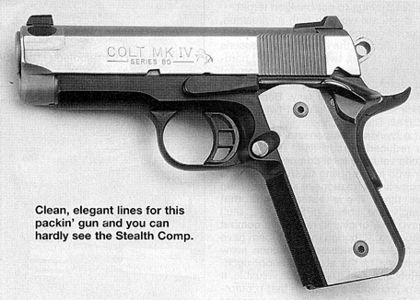
Despite my admittedly facetious introduction to this story, I do understand why modern compensators are popular. At the instant of firing, all firearms are supported from below and behind. The forces of recoil cause the gun, be it a 16-inch rifle on a battleship to a .25 Auto in me-lady’s hand, to drive back and up. That is recoiling against the point of their support, completely consistent with Newton’s laws of motion. No device can ever repeal these laws, but technology can somewhat trick the shooter by changing the way he perceives recoil. In the case of an automatic pistol chambered for a cartridge with a little bump to it, the effect of a compensator is to reduce muzzle flip. For most shooting purposes, this doesn’t really have that much practical value. But if it’s fast and furious, where there is a premium on on quick repeat shoots, then a device that reduces muzzle flip is valuable. Why? Well, its simply a matter of a lesser distance the shooter has to move the gun to get back to target.
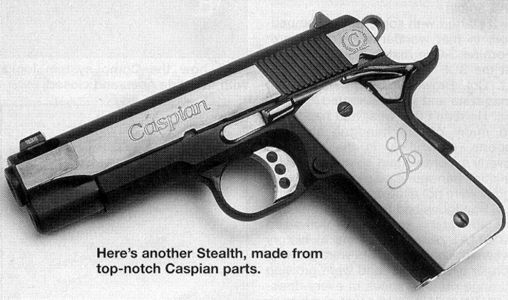
If you are working with a wheel gun, a good compensator can have a beneficial effect in the sense that it lessons the muzzle-up, twisting effect of hard kicking ammo. This movement assualts the web of the shooter’s hand in a usually painful way. Because of their shape, autos cannot twist much, if at all. Therefore, the major advantage of a working coompensator on an auto is reduced muzzle rise, That can be quite valuable for a competitive shooter who is struggling to shave seconds (sometimes fractions of a second) from his time. The shooting sports that emphasize speed (IPSC, IDPA, etc.) have their origins in real world combat shooting. Although many of them have drifted a considerable distance away from reality, the ability to shoot accurately, and fast (DVC) is still valuable. It was just such a situation that promted Tussey to develop the compensator system and the little pistol you see in this article.
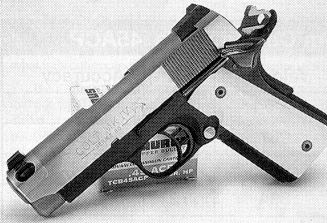 It started with some of the competitors in that wonderful old Soldier of Fortune 3_Gun match held every year at the SOF Convention in Las Vegas. Lt. Col. Brown, the man behind the magazine and match, wanted it realistic. He didn’t like what had happened to many of the handgun shooting sports, particularly in the sense of overly expensive and completely unrealistic handguns. So called “race” guns were not allowed in those matches. Handguns had to fit into a box that would just accept a full-sized M1911A1 pistol. At a time in history where the compensators were growing longer every month and were growing strange protuberances in every direction, Brown’s mandate was a return to sanity.
It started with some of the competitors in that wonderful old Soldier of Fortune 3_Gun match held every year at the SOF Convention in Las Vegas. Lt. Col. Brown, the man behind the magazine and match, wanted it realistic. He didn’t like what had happened to many of the handgun shooting sports, particularly in the sense of overly expensive and completely unrealistic handguns. So called “race” guns were not allowed in those matches. Handguns had to fit into a box that would just accept a full-sized M1911A1 pistol. At a time in history where the compensators were growing longer every month and were growing strange protuberances in every direction, Brown’s mandate was a return to sanity.
Some of the SOF shooters were Tussey’s customers. The rules of the game did not allow any that extended beyond the normal length of the gun. This situation got Terry to scrtching his head. In the past other pistolsmiths had tried to build things that would meet these specificatin, but Tussey wanted to come up with something that was uniquely his. After a few abortive attempts, Tussey came up with a design that he has built for various guns for nearly 15 years. He calls it a Stealth Comp.
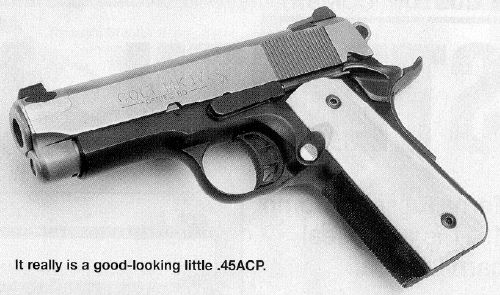
Our Stealth aircraft, occasionally seen flying the skies around Edwards AFB in the Mojave Desert, are airplanes built with technology that precludes their being seen by enemy radar. A compensator wearing the stealth moniker would have to be one that is equally invisible. That is pretty much what Tussey came up with in Stealth Comp. Installed on the upper of some types of M1911A1, the Stealth Comp matches the contur of the pistol slide perfectly. It adds nothing to the length or height of the gun. There are several other advantages, which I will get into in a moment, bt the bottom line is simply that it adapted compensator technology to a standard-sized pistol without increasing the size of the gun. It therefore fulfilled the original rule of fitting the box perfectly. Oh yeah, and it works.
Tussey builds these units one at a time and they are therefore a bit expensive. But they do tame the muzzle flip to an appreciable degree. The first step is to modify the top front corner of the slide by milling away a hefty chunk of steel. This essentially notches the entire front corner, as far back as approximately three-quarters of an inch. The cut goes down from the top just about the same amount. Obviously, this leaves a huge gap in the front end of the slide. The gap gets filled up when the pistolsmith builds the body of the compensator from a steel block that’s threaded onto the muzzle end of the barrel. Where the notch is a negative, the compensator body is a positive that fills the hole. With great care, the pistolsmith makes sure the contours of the slide match those of the comp.

Note how the comp system looks with the slide open and closed
To vent expanding powder gasses upward, thereby driving the gun downward against its natural tendency to rise, there has to be ports. Tussey cuts two of them in the top surface of comp/barrel unit. A wide oval port is on each side of the centerline of the gun. The gas therefore goes to either side, but not straight up. Unlike many other compensator systems, this one allows the pistolsmith to install a front sight at the front end of the barrel. In this case, it was a XS Sights Big Dot. There’s no problem with the hot vented gasses attacking the sighting element, because they go to the sides of the sight. To ensure maximum compensator efficiency, the interior of the unit is configured to form an expansion chamber. When the system is installed and fitted to a necessary recoil spring guide rod, it is then polished to a matching perfect fit with the slide. This final fitting is what makes the Stealth stealthy, in the sense that it’s hard to see. Look close at the accompanying pictures and you can barely see the line where the slide and comp come together.

As mentioned earlier, Tussey’s Stealth Comp system adapts to Colt M1911s and many of the clones thereof. Terry has put them on guns with slides from 3 to 6 inches in length. The main gun pictured in this article is Tussey’s own regular carry pistol, which he regretfully surrendered for the time it would take me to photograph, fire and write it up. It is made from an Officer’s ACP with a 3.5 inch barrel. Another gun is shown for comparison. This one was made for the wife of a friend, using those excellent Caspian parts. He is in the process of putting one together for me, based on a Para-Ordnance LDA Carry.
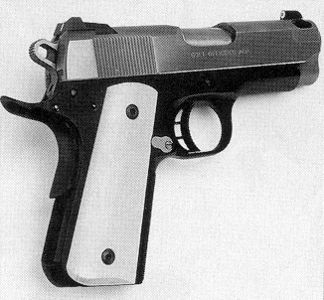
It fits your hand in a familiar fashion, but behaves like a heavier pistol
Obviously, there is more craftsmanship here than what went into the comp system. Many shooters like the little ACP-sized pistols with the short butt and short slide. Modern magazines for these guns hold 7 rounds and the overall size is just right for all day, everyday carry. Tussey builds plenty of pistols in this size bracket, although he can go smaller. Tussey pays much attention to the ergonomics of a custom handgun and has developed an interesting modification for the short butt versions of the old classic.
If you have medium-to large-sized hands, the short butt M1911s can be a problem. Take one of them in your hand in a one-handed shooting grasp. Note where the bottom rear corner of the butt ends up in relation to your hand. In my hand, that sharp corner is right in the middle of the heel. When I fire the gun with serious defensive ammo, it has a marked tendency to dig into the meaty part of my hand. Tussey remedies this situation with a modified frame and mainspring housing. He carefully rounds that edge that reduces the sharp corner. It also allows my hand to come around the butt far enough to put a little more of my hand behind the gun. This subtle re-shaping helps considerably in controlling a small light handgun chambered for a powerful cartridge.
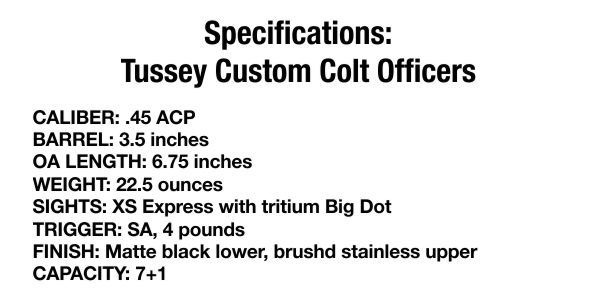
Tussey gave his own pistol all of the best touches. It’s a lightweight, an aluminum alloy receiver, and he carefully checkered the front strap in a 30 lines-per-inch pattern. The receiver is finished in a dull matte black color. I also note that he included another efficient custom touch that I also like, a modest relief cut under the base of the triggerguard. This feature moves the hand just a little bit closer to the bore axis.
On this gun, Tussey went with those increasingly popular XS Express sights, featuring a shallow “V” rear sight and tritium Big Dot front. The system is fast and right at home on a defensive gun of this sort. A final touch is a pair of slim ivory (the real stuff) grip panels. They give the gun an elegant touch.
Shooting Impressions
My range session was short, but I fired enough from the bench to tell me this is a decently accurate little pistol. More to the issue of the compensator efficiency, I, I fired it in several fast exercises at about 10 yards. Shooting as fast as I could, pressing the trigger and re-acquiring my sight alignment, I was able to get a magazines off pretty quickly and keep all of the shots in a group of about three inches. Some of that is a result of the fast sights, more from the gun’s ergonomics. But the majority of it comes from the nifty Stealth Comp. Like I say, I’m beginning to like compensators.
For more information contact:
Tussey Custom
24 Moonlight Rd., Unit A Dept CH,
Carson City, NV 89706
775-246-1533
Article By Wiley Clapp
Combat Handguns
February 2004

